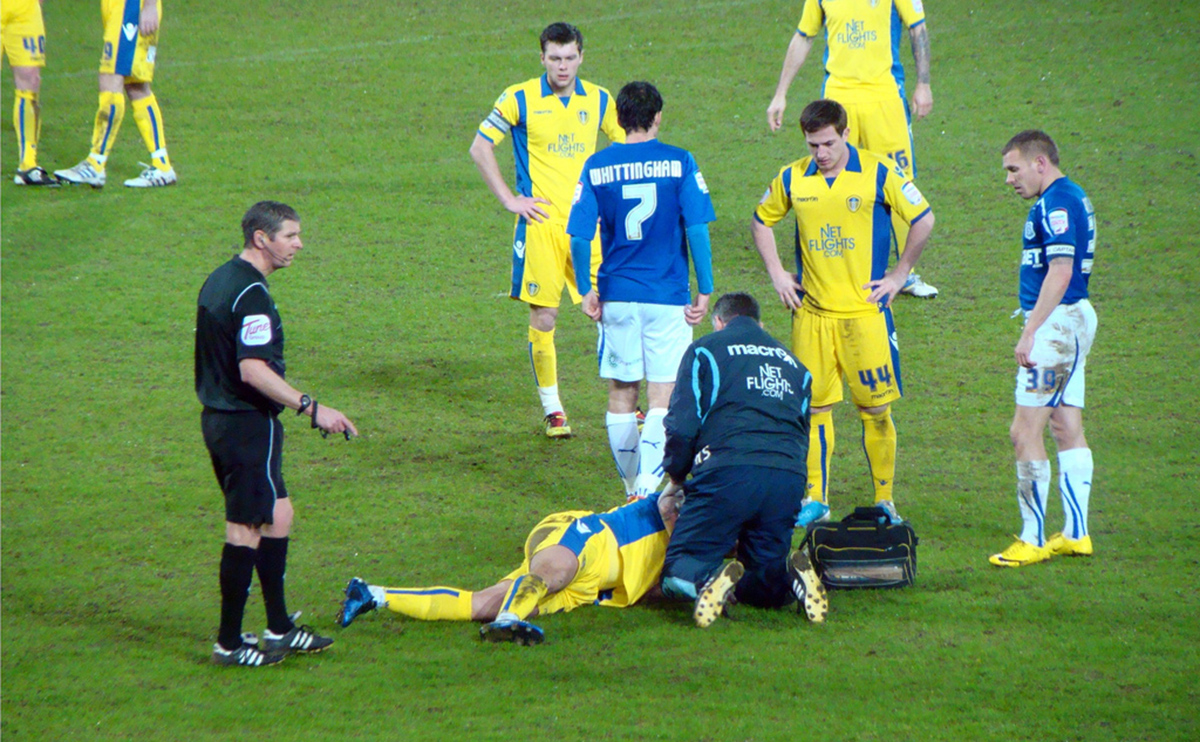A recurring headline in American sports news is the shocking frequency of a condition called chronic traumatic encephalopathy, or CTE. CTE is the result of years of repeated, small, traumatic brain injuries. These are not injuries that are severe enough to be diagnosed as a concussion. Each injury seems to cause the brain to protect itself by producing a substance called tau-protein. In small amounts, this tangled, filamentatious protein is not necessarily harmful to the brain, but in large amounts it can "strangle" neurons so that they can no longer send messages to each other.

In time, changes in the structure of the brain produce visible symptoms. At first there is something similar to attention deficit disorder, plus memory problems and headaches. Later there can be erratic behavior, difficulties in social interaction, and episodes of poor judgment. In its end stages, the face can take on a mask-like appearance (hypomimia), movement can become difficult, speech can become slurred, and there can be profound depression. Players who have just enough CTE to still be mobile are at high risk of suicide.
CTE Has Become a Major Concern in American-Style Football
American-style football offers many examples. Between 2008 and 2010, Dr. Ann McKee announced that she had found evidence of a condition called chronic traumatic encephalopathy (or CTE) in the brains of 12 deceased American football players. In 2011, Dr. Bennet Omalu, a forensic pathologist, announced that he had found evidence of a condition called chronic traumatic encephalopathy in the brains of football players Andre Waters, Terry Long, Justin Strzelczyk, Mike Webster, and Tom McHale, two of whom had died from suicide. The next year Kansas City Chiefs lineback Jovan Belcher killed his girlfriend and then drove to the stadium and killed himself in front of the team's general manager and head coach. His family demanded an autopsy, and it was later announced that he also had CTE. As this article is being written in November of 2016, 90 out of 94 deceased National Football League Players autopsied by Dr. McKee have been diagnosed with CTE.
READ Soccer Greatly Improves Health In Young People
CTE Isn't Just a Problem in American Football
CTE has been identified in star athletes in Australian rules football, Major League Baseball, pro wrestling, ice hockey, bull riding, rugby, mixed martial arts, and extreme sports. Major League Baseball outfielder Ryan Freel was found to have had CTE after he killed himself in 2012. Australian rugby union player Barry "Tizza" Taylor died of CTE in 2013. CTE was found in the brain of mixed martial arts star Jordan Parsons after he was killed by a drunk driver in 2016. Now researchers are looking at the possibility of brain damage from heading the ball in soccer, the game people outside North America usually call football. (For the rest of this article, I'll refer to the game as soccer.)
What Is The Evidence for CTE in Soccer Players? And What Can Be Done About It?
Researchers at university medical schools and hospitals in the UK and South Africa recruited 19 amateur soccer players aged 19 to 25, 14 of them men, five of them women, to participate in a study of the potential for brain injury from heading the ball. They had them head machine-projected soccer balls at standardized speeds. Each player was asked to rotate the ball with his or her head, heading the ball 20 times in a 10-minute session.

After the session, the players were given standardized tests of short- and long-term memory. They were also given tests to determine how fast their knee and thigh muscles could respond to a signal from their brains to determine whether their reflexes were as fast after the session as before, and whether they could could pick themselves up as quickly after a simulated fall (done in a way not to cause further injury to the players). The tests showed that the players had memory impairment, slower reflexes, and a poorer sense of balance after heading the ball 20 times than before. The tests also showed that they returned to normal after 24 hours.
Of course, in the real world, athletes can "play dumb" during their pre-season physicals so any loss of mental abilities during the season isn't detected. No pre- and post-test of brain function in athletes who participate in contact sports is infallible. This test suggests that just one trip to the field causes at least short-term damage to the brain. But does it prove that heading the ball causes long-term injury to the brain.
At least one expert says it probably does cause long-term injury in amateur players, but not in professional players.
If you've watched little kids play soccer, you probably saw a lot of them jumping up to catch the ball with their heads, or heading the ball from the top of the head rather than the forehead. There are sutures in the top of the head, which are stressed in an amateur player, that aren't stressed by a more experienced player. A more experienced player will have stronger neck muscles, which also absorb part of the force of the ball. Simply having a ball thrown at your head, however, doesn't give your face and neck muscles the same opportunities to cushion your brain.
READ Neuromuscular Programme Drastically Reduces Soccer Injuries
A few months ago I sat down with University of Texas neuroscientist Dr. Steven Kornguth, who branched out from studying brain responses in soldiers in combat to studying long-term brain injuries in soccer players. As I understood him, he explained that the CTE is relatively rare in soccer players because:
- Young soccer players have growing brains that do not tend to generate the tau-proteins that repair injury in the adult brain, and adults play less soccer, and
- The repair proteins that cause long-term loss of brain function respond to diffuse forces more than they respond to concentrated forces.
The better the player's technique, the more concentrated the force, and the less of the kind of damage that causes long-term damage. This is not to say that professional soccer players can't develop CTE, but they do at a much lower rate because they can control the exposure of the head to the force of the ball.
Dr. Kornguth also noted that there may be novel ways of undoing the damage of repeated traumatic injury to the brain. Notably, the acne antibiotic minoxidil interferes with the formation of plaques in the arteries and in the brain. Ironically, soccer players getting treated for acne conceivably could have some protection from head injuries for soccer. You shouldn't start taking minoxidil on your own to treat what you fear may be CTE. However, raise the question with your neurologist to see if protocols for preventing progress of the disease have been approved.
And if you are an adult who still loves playing soccer, keep refining your skills. The more expertly you can head the ball, the less injury you will do to your brain.
- Di Virgilio TG, Hunter A, Wilson L, Stewart W, Goodall S, Howatson G, Donaldson DI, Ietswaart M. Evidence for Acute Electrophysiological and Cognitive Changes Following Routine Soccer Heading.EBioMedicine. 2016 Oct 23. pii: S2352-3964(16)30490-X. doi: 10.1016/j.ebiom.2016.10.029. [Epub ahead of print] PMID: 27789273.
- Photo courtesy of joncandy: www.flickr.com/photos/joncandy/5325362142/
- Photo courtesy of freepik.com
- Photo courtesy of freepik.com


Your thoughts on this